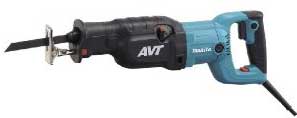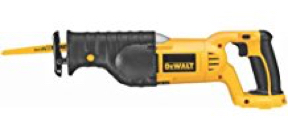|
Corded Reciprocating Saw
Corded recipocating saws are offered by most of the major power tool brands, with the proper blade they will cut either wood or metal. Most offer variable speeds from 0 - 3000 strokes per minute with orbital actions.
Cordless Reciprocating Saw
Cordless reciprocating saws are often more
convient than the cordless models, with L-ion batteries the charge lasts
much longer than the older style batteries. UsesThese saws are used primarily in demolition or renovations to remove existing structures. They are also used to cut plastic pipe, this actually works best with a dull blade. Blades come in various lengths, shorter blades are more stable and will result in a squarer cut, longer blades can be flexed to make a flush cut. Generally the blades are installed with the teeth pointing down, however in some situations the blade can be reversed to make the cut. Home owners use them to prune tree branches, they are also handy to cut roots when removing stumps. Metal cutting blades are handy to cut the nails between two boards that have been nailed togeher. Reciprocating Saw SafetyNOTE: Never use a saw or any power tool while under the influence of drugs or alcohol. Read your owners manual for additional tips and safety features. 1. Wear safety goggles. 2. Tie back loose hair, tuck in long beards, and remove dangling jewelry or watches. 3. Make sure your sleeves are tight at your wrist, wearing long pants is recommended while wood working. 4. Use clamps to secure the cutting material to the work surface. 5. Always unplug and turn off the saw when you are changing or tightening the blade. Select the correct blade for each type of material you are cutting. Make sure your saw cutting speed is set for the type of material you are cutting, slower for metal, faster for wood, see manual for details. 6. Never start the saw while the blade is touching the wood. 7. Do not start cutting until the blade is running at the proper speed. 8. Check behind the cutting surface to make sure you have enough clearance for the blade to go back and forth without hitting any thing.
|

